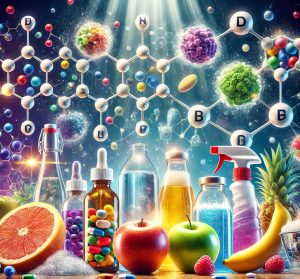Electrolytes and Conductance
Electrolytes are substances that dissolve in water (or other solvents) to produce ions, which can conduct electricity. This process of dissociation creates positively and negatively charged ions that are free to move in the solution, allowing electrical current to pass through it.
Conductance in electrolytes, therefore, is a measure of how well the electrolyte solution can conduct electricity, which is directly related to the movement of ions within the solution. Conductance is the inverse of resistance and is represented by the symbol GGG, measured in Siemens (S). Conductance essentially reflects the ease with which electric current can flow through a solution.
Types of Conductance
Electrolyte conductance can be divided into two main types:
- Specific Conductance (κ):
- Specific conductance (or conductivity) is the conductance of a solution in which ions can move freely between two electrodes placed 1 cm apart, and each with an area of 1 cm².
- It is expressed as: κ=1R×lAκ = \frac{1}{R} \times \frac{l}{A}κ=R1×Al where RRR is resistance, lll is the distance between electrodes, and AAA is the area of the electrodes.
- Conductivity (κκκ) is typically measured in S/cm.
- Molar Conductance (Λm):
- Molar conductance is defined as the conductance of all ions produced by one mole of an electrolyte in a solution.
- It is given by: Λm=κcΛ_m = \frac{κ}{c}Λm=cκ where κκκ is the specific conductance and ccc is the concentration in mol/L.
- Molar conductance increases as dilution increases because ions can move more freely in less concentrated solutions.
Conductance in Strong and Weak Electrolytes
- Strong Electrolytes:
- Strong electrolytes, such as sodium chloride (NaCl) and hydrochloric acid (HCl), dissociate completely into ions in solution.
- Conductivity remains high, even at higher concentrations. The conductance of strong electrolytes varies only slightly with concentration.
- Weak Electrolytes:
- Weak electrolytes like acetic acid (CH₃COOH) partially dissociate in solution.
- Conductance increases significantly with dilution because more ions dissociate as concentration decreases.
- The relationship between molar conductance and concentration is more complex in weak electrolytes, often following Ostwald’s dilution law.
Factors Affecting Electrolyte Conductance
Conductance of electrolytes depends on multiple factors:
- Nature of the Electrolyte:
- Strong electrolytes yield more ions than weak ones, resulting in higher conductance.
- Concentration:
- At high concentrations, ions face greater inter-ionic attractions, reducing their mobility and conductance.
- At low concentrations (more dilution), conductance increases as ions move more freely.
- Temperature:
- Conductivity generally increases with temperature since higher temperatures boost ion mobility.
- Solvent and Dielectric Constant:
- Solvents with a high dielectric constant (e.g., water) better stabilize ions, aiding dissociation and increasing conductance.
- Size and Charge of Ions:
- Smaller and more highly charged ions move faster in solution, enhancing conductance.
- Presence of Complex Ions:
- Some electrolytes form complex ions that can decrease the number of free ions, reducing conductance.
Measurement of Conductance
Conductance measurements typically involve using a conductivity cell with two platinum electrodes immersed in the electrolyte solution. An AC voltage is applied to avoid electrolysis, and the resulting current is measured to calculate conductance.
Applications of Electrolyte Conductance
- Water Purity Testing:
- High conductivity indicates impurity in water, as pure water has very low conductivity.
- Medical Applications:
- Electrolyte conductance is important in assessing electrolyte balance in body fluids.
- Industrial Applications:
- Conductivity is used in quality control in industries like pharmaceuticals and food, where electrolyte levels are crucial.
- Environmental Monitoring:
- Conductivity measurements help monitor pollution levels in natural water bodies.
- Batteries and Fuel Cells:
- Conductance affects the efficiency of electrolytes in batteries and fuel cells, where ion mobility is critical.
Theoretical Models of Conductance
- Kohlrausch’s Law:
- Kohlrausch’s Law states that the molar conductance of an electrolyte at infinite dilution is the sum of the individual contributions of its ions.
- Debye-Hückel-Onsager Theory:
- This theory describes the conductance behavior of electrolytes in dilute solutions, accounting for ionic interactions.
- Ostwald’s Dilution Law:
- This law explains the relationship between the degree of dissociation of weak electrolytes and their concentration.
Practical Example of Conductance in Strong vs. Weak Electrolytes
Let’s consider the conductance of NaCl (strong electrolyte) and CH₃COOH (weak electrolyte):
- NaCl: Dissociates completely, so conductance remains high across concentrations.
- CH₃COOH: Dissociates partially; therefore, its conductance increases significantly with dilution as more ions are produced.
Advanced Concepts: Equivalent Conductance and Mobility of Ions
- Equivalent Conductance (Λeq):
- Defined for equivalents of ions rather than moles, equivalent conductance is used in scenarios where reactions are based on equivalents, such as in acid-base titrations.
- Ionic Mobility:
- It is the speed at which ions move under an electric field. Ions with higher mobility contribute more to conductance.
Certainly! Here are 10 questions about electrolyte conductance, along with concise explanations for each answer:
1. What is electrolyte conductance?
Answer: Electrolyte conductance is the ability of an electrolyte solution to conduct electricity. This occurs when an electrolyte dissolves in water (or other solvents) and dissociates into positive and negative ions that can carry electrical charge through the solution.
2. What is the difference between strong and weak electrolytes?
Answer: Strong electrolytes, such as NaCl and HCl, dissociate completely into ions in solution, leading to high conductance. Weak electrolytes, like acetic acid (CH₃COOH), partially dissociate, resulting in fewer ions and lower conductance. Strong electrolytes have higher conductance and are less affected by changes in concentration, whereas weak electrolytes show significant increases in conductance with dilution.
3. What is specific conductance (κ), and how is it measured?
Answer: Specific conductance, or conductivity (κ), is the conductance of an electrolyte solution between two electrodes 1 cm apart and each with a 1 cm² area. It measures how well the solution conducts electricity per unit length and area and is typically measured in Siemens per centimeter (S/cm). It is determined using a conductivity cell with an AC current to avoid electrolysis.
4. How is molar conductance (Λm) calculated?
Answer: Molar conductance (Λm) is calculated by dividing specific conductance (κ) by the concentration of the electrolyte in moles per liter:Λm=κcΛ_m = \frac{κ}{c}Λm=cκ
where ccc is the concentration. Molar conductance helps determine the conductance provided by one mole of an electrolyte in a solution.
5. What happens to molar conductance as the concentration of a solution decreases?
Answer: As the concentration decreases, molar conductance generally increases. This is because the ions in a dilute solution experience less inter-ionic attraction, allowing them to move more freely and conduct electricity more effectively.
6. Why does temperature affect electrolyte conductance?
Answer: Temperature affects electrolyte conductance because higher temperatures increase the kinetic energy of ions, making them move faster. This enhanced movement increases conductance as ions can carry electric current more effectively. Conductivity typically rises with an increase in temperature.
7. What is Kohlrausch’s Law of Independent Migration of Ions?
Answer: Kohlrausch’s Law states that at infinite dilution, the molar conductance of an electrolyte is the sum of the conductance contributions from each ion, regardless of the other ions present. This means that each ion contributes independently to the total conductance, allowing for the calculation of ion-specific conductance values.
8. How does the dielectric constant of a solvent affect electrolyte conductance?
Answer: A solvent with a high dielectric constant can better separate and stabilize ions in solution, reducing inter-ionic attraction and promoting greater dissociation. This increased dissociation leads to more free ions in solution, thereby increasing conductance. Water, with a high dielectric constant, is an effective solvent for many electrolytes.
9. What is the significance of ion size and charge in electrolyte conductance?
Answer: Smaller ions with higher charges generally have higher mobility and, hence, contribute more to conductance. Small ions can move more easily in solution, while ions with higher charges create stronger electric fields that accelerate their movement under an electric current, enhancing conductance.
10. How does electrolyte conductance apply to real-world scenarios?
Answer: Electrolyte conductance has numerous applications:
- Water Quality Testing: Conductivity measurements can assess water purity, as higher conductivity indicates more dissolved ions (impurities).
- Medical Diagnostics: Blood and urine electrolyte levels are monitored based on conductance to diagnose health conditions.
- Battery and Fuel Cells: Electrolyte conductance is crucial for efficient ion movement, affecting battery life and efficiency.






